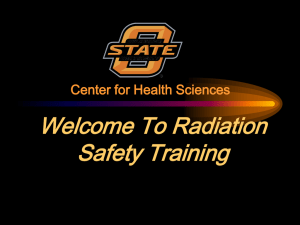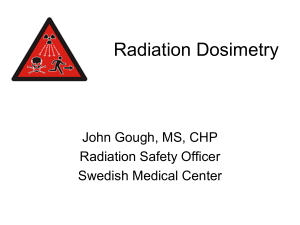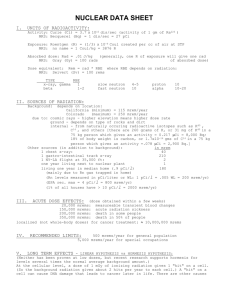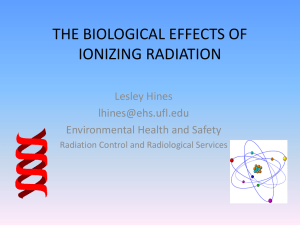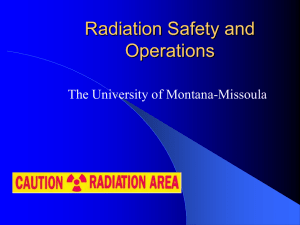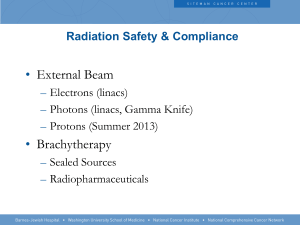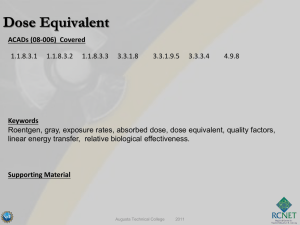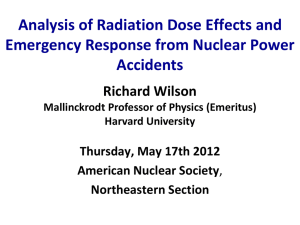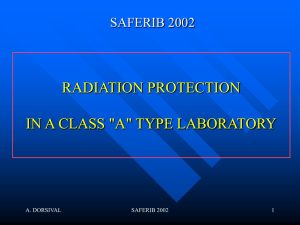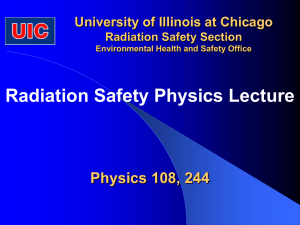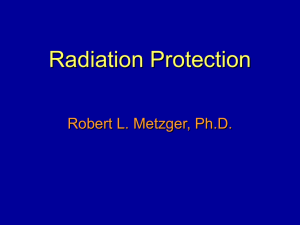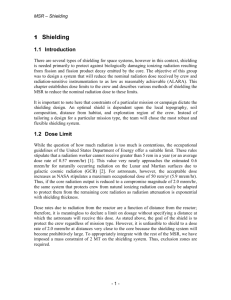PET/CT: Radiation Safety and Protection
advertisement
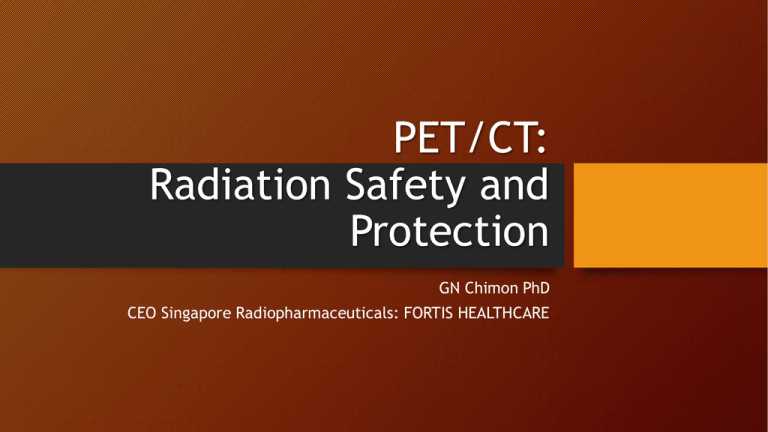
PET/CT: Radiation Safety and Protection GN Chimon PhD CEO Singapore Radiopharmaceuticals: FORTIS HEALTHCARE Educational Objectives • Radiation regulatory limits • PET exposure/dose calculations • Radiation safety Outline • Introduction to principles of radioactive materials • Radiation regulatory limits • PET exposure/dose calculations • Radiation safety principles • PET isotope shielding • Typical exposure to staff Types of Radiation • Ionisation: electron in the inner orbit receives sufficient energy to escape from the nucleus, forming a positive and negative ion • Ionisation radiation is emitted when an electron from an outer shell falls in to take the place of the electron that was ejected • Ionisng radiations cause ionisation when they pass through matter • Different types of ionising radiation have different energies: particles can be stopped by a sheet of paper. -particles can be stopped by 1 cm of plastic. -rays and x-rays need lead for shielding, the thickness depending on the energy of the radiation Activity of Radioactive Materials • The activity of radionuclide is a measure of the radioactivity of the substance. It is determined by the number of disintegrations per second (Bq). The activity of a radioactive material varies with time exponentially • A = A0 e-t • A = current activity at time t • A0 = original or initial activity • e = base natural log • t = amount of time elaspsed from A to A0 • λ = Radioactive decay constant • Relationship between half life and radioactive decay constant: • T½ = In2/ Radionuclide Half-Life • The half-life is a characteristic of the radionuclide. It is not related to the atomic number or mass number of the material • After 2 half- lives the activity is one quarter (1/2)2 its initial value • After 3 half-lives the activity is one eighth (1/2)3 its initial value • After 10 half-lives, the activity is (1/2)10 = (1/1024) i.e. about one-thousandth its initial value • In general, the activity after n half-lives is (1/2)n its initial value Equivalent Dose • Equal absorbed doses of different radiations do not necessarily produce biological effects of the same magnitude • one unit of absorbed dose to a tissue from alpha radiation is much more harmful than one unit of absorbed dose from beta radiation • The absorbed dose of each type of radiation, must be multiplied by a radiation weighting factor WR which reflects the ability of the particular type of radiation to cause damage • The quantity obtained after such multiplication is known as the equivalent dose i.e. • Equivalent Dose = Absorbed Dose x Radiation Weighting Factor Weighting Factors Type of ionising radiation and energy range Photons, all energies Radiation weighting factor 1 Electrons and muons, all energies 1 Neutrons, energy, 10 keV 5 10 keV to 100 keV 10 >100keVto 2 MeV 20 >2 MeV to 20 MeV 10 >20 MeV 5 Protons, other than recoil protons, energy >2MeV 5 Alpha particles, fission fragments, heavy nuclei 20 Unit Equivalent Dose: mSv/Sv • UED is the sievert (Sv). Represents doses received by human beings • Radiation dose depends on the activity (Becquerel, Bq) of a radioactive source, the distance from the source, whether there is any shielding, and the exposure time. The old unit for the equivalent dose is expressed in rem • 1 Sv = 100 rem • 1 mSv = 100 mrem • 1 Sv = 0.1 mrem • The sievert expresses biological effect on the human body. In radiation protection it is the biological effect of radiation which is of interest Regulatory Requirements • The Federal Code of Regulations 10 CFR20 establishes the effective dose equivalent limits (NCRP116) • Occupational = 50 mSv/yr = 5000 mrem/yr • Public = 1 mSv/yr = 100 mrem /yr • Shielding design limits (NCRP 147) • Occupational = 5 = 500 mrem/yr = 10 mrem/wk • Public = 1 mSv/yr = mrem/yr = 2 mrem/wk Radiation Dose from PET Radiopharmaceuticals A D Average Activity • Activity decays exponentially during any substantial period of exposure to radiation • PET radionuclides have short half-lives Shielding Basics • Radiation dose design limits • Radiation safety principles • Time, Distance, Shielding • The ALARA principle • As Low as Reasonably Achievable • Consider surrounding (all six directions) Radiation Safety Principles • Time • Exposure varies linearly with time • reducing exposure time by half reduces absorbed dose by half • Minimize time personnel must spend in high exposure rate areas • Uptake rooms • Scanner rooms • Hot patient proximity Radiation Safety Principles • Distance • Exposure follows inverse-square law (1/D2) • Increase distance by 2 decrease the exposure by 4 • Within a meter, 2/D may be more accurate Radiation Safety Principles: HVL HVL 1 2 4 8 Transmission 0.50 0.25 0.0625 0.0039 Material Concrete Iron Lead HVL @ 511 keV ~8 cm ~ 5 cm ~2 mm Occupancy Factor • Allows for partial occupancy with T the occupancy factor. P represents design dose per Wk • T is the weekly (40 hr) fraction of the time the location is occupied • Shielding barrier is acceptable if it decreases the dose to P/T. - if T<1, the “fulltime” dose will be P/T; any shielding requirements unlikely Barrier Thickness: How Much Shielding? • Typically Physicist given an exposure level and shielding goal • Calculate the attenuation factor and corresponding # of HVL to achieve it • Xbarrier = Target Exposure / Actual Exposure • NHVL = -In(Xbarrier) / In(2) • Barrier thickness depends on barrier material (attenuation) • Tbarrier = NHVL x HVLbarrier Sample Calculation • NM Tech exposure during PET scan • Assume 6.5 mCi of F-18 FDG located 3 m away for 30 minutes • Activity @ start = 6.5 mCi; @ end = 5.4 mCi • • • • • Average activity, A = 5.95 mCi D = 3 m, T = 0.5hr/40hr = 0.0125 Dose/patient = 0.43 µSv/wk Dose for 80 patients/wk = 34 µSv/wk Sample Calculation • • • • • • NM Tech exposure during PET injection Assume 15 mCi of F-18 FDG located 1 m away for 5 minutes Average activity, A = 15 D = 1 m, T = 0.083 hr/40 = 0.0021 Dose/patient = 0.0017 mrem/wk Dose for 80 patients/wk = 0.14 mrem/wk Sample Calculation • Public area adjacent to radiopharmacy • Assume unshielded exposure 10 mrem/wk • Shielding design limits: 2 mrem/wk • Office: Occupancy = 1 • Attenuation factor • Xbarrier = 2 mrem / 10 mrem = 0.2 • NHVL = –In(0.2)/In(2) = 2.32 • TLEAD = NHVL x HVLLEAD = 2.32 x 5 mm = 11.6 mm Sample Calculation • Public area adjacent to radiopharmacy • Assume unshielded exposure 10 mrem/wk • Shielding design limits: 2 mrem/wk • Waiting area: Occupancy 1/20 • Attenuation factor • Xbarrier = (20) * 2 mrem / 10 mrem = 4 • Xbarrier = P/T = < 1 implies no shielding required PET/CT facilities represents unique challenges for shielding • Annihilation radiation is energetic & highly penetrating • Eγ = 511 keV; HVL ~ 5 mm Pb (broad-beam) • Movement of radioactive patients in the clinic results in radiation sources that are stationary in neither space nor time • e.g., T1/2 of F-18 ~ 110 min • Space is a premium – making distance hard to exploit • Adjacent location within PET facilities are usually occupied • Increasing demand for PET-CT examinations • Scanners operate continuously for 8-10 hours/day Thank You Be Safe
